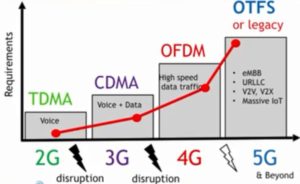About Course
Orthogonal frequency division multiplexing (OFDM) is a key transmission method used in 4G, 5G, WiFi, WiGig, LiFi, DVB, VDSL, Optics, etc.
orthogonal frequency division multiplexing in Details. What is it? Why should you know it? What are its merits/advantages & demerits? and how to simulate it and understand its main building blocks? All these and more will be learned in this dedicated training…

Orthogonal Frequency Division Multiplexing (OFDM) is a communication method used in wireless and wired networks that utilizes a large number of closely-spaced orthogonal sub-carriers to transmit data. This allows for a higher data rate and more reliable communication than traditional narrowband transmission techniques. OFDM is commonly used in wireless networks such as Wi-Fi, LTE, and 5G, as well as wired networks such as DSL and Ethernet.
OFDM works by splitting the available bandwidth into multiple sub-carriers, each of which is assigned a unique frequency. Data is then spread across the sub-carriers using a technique known as orthogonal frequency-division multiplexing. This allows for more data to be sent through the same bandwidth, since each sub-carrier is carrying its own data stream. The data is then modulated onto the sub-carriers, and the signals are combined into one signal that is transmitted to the receiver. To ensure reliable communication, OFDM uses a number of error-correction techniques such as forward error correction (FEC), channel coding, and interleaving.
FEC adds redundant information to the signal, which can be used by the receiver to identify and correct any errors that may have occurred during transmission. Channel coding is used to ensure that the signal is resistant to noise and interference. Interleaving is used to spread out errors that may occur over multiple symbols, reducing the impact of single errors on the data. OFDM also uses various methods to reduce the signal’s sensitivity to multipath fading, which can occur when the signal is reflected off of buildings and other obstacles.
These methods include the use of guard intervals, which are short segments of the signal that are used to ensure that the signal can be accurately received even if it is delayed by multipath fading. The use of cyclic prefixes, which are short segments of the signal that are added at the beginning of each symbol, is also used to reduce sensitivity to multipath fading. The implementation of OFDM requires a strong understanding of the underlying principles and technologies.
Training courses in OFDM typically focus on the fundamentals of the technology, including OFDM modulation, OFDM multiplexing, error-correction techniques, and signal processing techniques. These courses also provide students with an understanding of the hardware and software components required to implement OFDM, as well as the tools and techniques used to optimize the performance of the system.
OFDM has become an integral part of modern communication systems, and training in OFDM is becoming increasingly important for those seeking to take advantage of the technology. With the ever-increasing demand for higher data rates, OFDM is becoming an essential tool in the arsenal of communication engineers.
OFDM has become an integral part of modern communication systems, and training in OFDM is becoming increasingly important for those seeking to take advantage of the technology. With the ever-increasing demand for higher data rates, OFDM is becoming an essential tool in the arsenal of communication engineers.
OFDM has become an integral part of modern communication systems, and training in OFDM is becoming increasingly important for those seeking to take advantage of the technology. With the ever-increasing demand for higher data rates, OFDM is becoming an essential tool in the arsenal of communication engineers.
OFDM has become an integral part of modern communication systems, and training in OFDM is becoming increasingly important for those seeking to take advantage of the technology. With the ever-increasing demand for higher data rates, OFDM is becoming an essential tool in the arsenal of communication engineers.
Join now!
Course Content
OFDM in Details. Why should you know it? What is it? and What are its merits/advantages & demerits?
-
OFDM concept, features and transceiver structure
01:17:00 -
OOBE, PAPR, Power Ranging, coding, scheduling, and mathematical modeling
38:52
